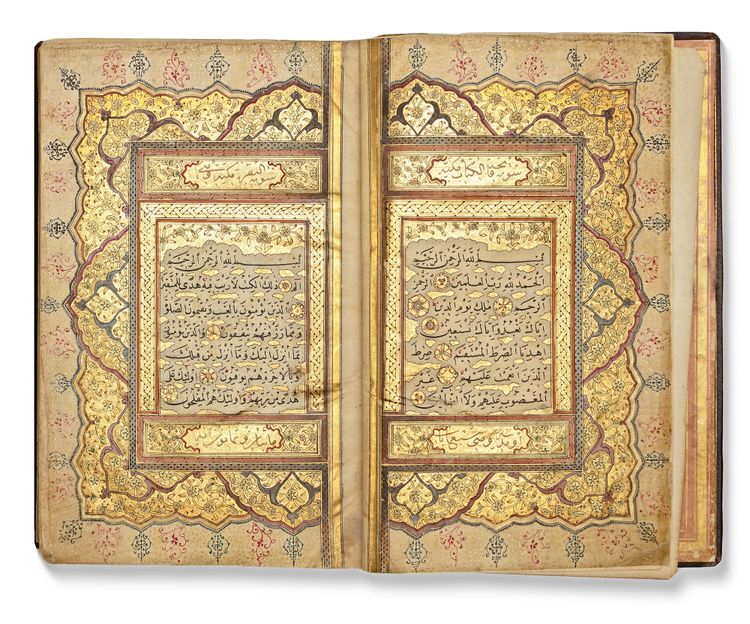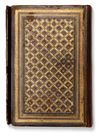Lot 110 AN ILLUMINATED OTTOMAN QURAN, SIGNED BY HAFIZ IBRAHIM AL-KARAHISARI, OTTOMAN TURKEY, DATED 1227 AH/1812-13 AD
A complete Quran, Arabic manuscript on cream paper, 322 leaves with 2 fly-leaves, each page with 15 lines, written in black naskh script within gold and black rules, gold roundel verse markers outlined in black and pointed in polychrome dots. Surah headings in white thuluth script within gold and polychrome decorated cartouches, gold and polychrome marginal motifs indicating the 'Juz and Hizb'. Two opening biofolia with heavily gilt and polychrome decoration framing 7 lines of black naskh in clouds reserved against a sprinkled gold ground.
The last four pages with a prayer for completion of the recitation of the Quran (Dua'a al-khatm) and signed 'Hafiz Ibrahim el-Nasib Al-karahisari, student of Mahmud Celaluddin Effendi and dated 1227 AH.
In black leather morocco binding with flap decorated with gold painted central medallion and border.
10 by 14 cm.
Calligrapher: Beyond a laqab which suggests he came from the West Anatolian town of Karahisar, nothing is known about the scribe of this Quran from the published sources. The colophon of this manuscript, however, states that he learnt under Mahmud Celaluddin Effendi (d. AH 1245/1829 AD). Born in the Caucasus, Celaluddin became a prominent calligrapher in Istanbul in the early 19th century. He briefly enjoyed royal favour, completing an inscription for the tomb of Mihrishah, the mother of Selim III. Samples of his calligraphy on paper are in the Topkapi Palace Musuem (EH 273 and GY 322-9) and published as part of the Sakip Sabanci Collection (M. Ugue Derman, Letters in Gold: Ottoman Calligraphy from the Sakip Sabanci Collection, Istanbul, New York, 1998, pp.108-11). His students also enjoyed success in their own right: Mehmed Tahir Efendi would instruct Sultan Abdulmecid in the arts of calligraphy, while another student - Esma Ibret Hanim - was the most successful female calligrapher of her day.







